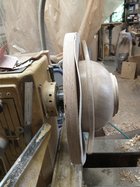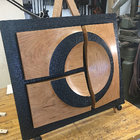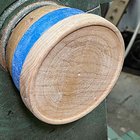I found myself going back to a simple chunk of turned wood with tailstock support for removing the tenons on bowls. I really don't like the way the vacuum chuck messes up the finish or pulls out oil. It's a frugal vacuum system with two sizes of hold fast chucks, but I just don't see a reason to use it anymore? I'm not even sure why I thought I "needed" one?? Probably the same reason I need 5 5/8 bowl gouges.
-
October 2025 Turning Challenge: Natural Edge Bowl! (click here for details) -
Congratulations to Curt Fuller for "Bell Ornaments" being selected as Turning of the Week for October 27, 2025 (click here for details) -
Welcome new registering member. Your username must be your real First and Last name (for example: John Doe). "Screen names" and "handles" are not allowed and your registration will be deleted if you don't use your real name. Also, do not use all caps nor all lower case.
You are using an out of date browser. It may not display this or other websites correctly.
You should upgrade or use an alternative browser.
You should upgrade or use an alternative browser.
Not using my vacuum chuck much
- Thread starter John Hicks
- Start date
Lance Mirrer
AKA "taxman"
Are you suggesting we don't all need 5 5/8 bowl gouges?
I don't understand????
I don't understand????
Huh. I use my vacuum chuck all the time and can no longer imagine making a nice bottom without the ability to get the tail stock out of the way. Once again, there are many ways to do everything in woodturning.
- Joined
- Apr 27, 2004
- Messages
- 9,292
- Likes
- 6,028
- Location
- Lakeland, Florida
- Website
- www.hockenberywoodturning.com
I seldom use my vacuum on bowls. Just quicker and easier to reverse chuck and friction drive.I found myself going back to a simple chunk of turned wood with tailstock support for removing the tenons on bowls. I really don't like the way the vacuum chuck messes up the finish or pulls out oil. It's a frugal vacuum system with two sizes of hold fast chucks, but I just don't see a reason to use it anymore? I'm not even sure why I thought I "needed" one?? Probably the same reason I need 5 5/8 bowl gouges.
Use vacuum on the occasional platter, some ornaments, and to hold some spherical forms for hollowing.
Still a great asset when i want it
john lucas
AAW Forum Expert
I use my vacuum chuck a lot.
- Joined
- Feb 6, 2010
- Messages
- 3,420
- Likes
- 2,502
- Location
- Brandon, MS
- Website
- threeringswoodshop.square.site
I use mine on most bowls. To echo how can you embellish the bottom without the VC as is so easy . And yes I once had a Longworth and a set of cole jaws there is just no comparison.
I use a Cole. Gonna buy the frugal one VC soon. Got to get it past the boss.
Bought a vacuum chuck and rotary coupling a while ago on a whim when I needed a tax write off, but still haven’t used them. Jam chucks are pretty simple and quick, and always perfectly centered.
john lucas
AAW Forum Expert
I have the threaded#2 Morse taper adaptor from best wood tools. It allows me to take the bowl with chuck still attached and put it in the tailstock. Thus allows me to perfectly align the bowl on the vacuum chuck. Push it up to the chuck, turn the vacuum on then release the chuck attached to the bowl. Very quick.
- Joined
- Jul 18, 2018
- Messages
- 1,308
- Likes
- 2,787
- Location
- Baltimore, MD
- Website
- loujacobswoodturning.com
I use my vacuum chuck quite a bit. Cole jaws are my go-to for anything under about 10 1/2” when the rim is suitable. My Longworth chuck hasn’t been used in several years. (Why do I still give it wall space?)
- Joined
- Jul 18, 2018
- Messages
- 1,308
- Likes
- 2,787
- Location
- Baltimore, MD
- Website
- loujacobswoodturning.com
I have the same adapter and use it whenever I’m using the vacuum chuck. It makes centering (almost) idiot-proof.I have the threaded#2 Morse taper adaptor from best wood tools. It allows me to take the bowl with chuck still attached and put it in the tailstock.
Not sure about the vac chuck, as I’ve yet to use/own one, but nothing wrong with 5 5/8” bowl gouges - I have 6. They will eventually be used! Makes it easier to try different grinds/angles etc on a particular piece of wood.
I purchased12 different 5/8" bowl gouges before I came to the conclusion that the magic one is unlikely to be discovered.
Wait a minute, SB Tools opens tomorrow!
Wait a minute, SB Tools opens tomorrow!
Last edited:
I never bought a vacuum chuck as it didn't seem like it would do any better job than a friction drive held with the tailstock, and you don't have all that extra gear hanging on the back of your headstock. The problem with the VC messing up a finish is something I don't understand, if applying a finish (partial) is required to pull a vacuum on a piece then that is another major point against the VC.I found myself going back to a simple chunk of turned wood with tailstock support for removing the tenons on bowls. I really don't like the way the vacuum chuck messes up the finish or pulls out oil.
It seems to me that any form of tailstock support will prevent extensive finishing and decorating of the bottoms of pieces. You might want to try the method described in the Tips and Techniques forum: Poor Man's Reverse Chucking System". (August 2020). It provides full access to the bottoms, and works in many situations where a vacuum chuck or Cole Jaws won't.
john lucas
AAW Forum Expert
I wrote an article on methods of reverse turning bowl for our club newsletter years ago. It covers just about every way except vacuum chucking. It's on our club web page under the tips and projects section. Www.cumberlandwoodturners.com
I use mine to finish the bottom of every bowl I make. It makes it too easy.
Lance Mirrer
AKA "taxman"
On the link, it's under methods and jigs.I wrote an article on methods of reverse turning bowl for our club newsletter years ago. It covers just about every way except vacuum chucking. It's on our club web page under the tips and projects section. Www.cumberlandwoodturners.com
Nice web with lots of info!!!
I've got a VC and have been using it quite a lot the past couple of years. But I've had some bad marks on finishes -- I guess I just can't wait a couple days for the finish to cure sufficiently for the VC to not mess things up. Plus, frankly, I've never been 100% confident that I'm not going to throw the piece off the chuck even with 25 lbs and using light cuts. I've recently purchased the 18" Vicmarc Adjust-a-jaw; I'm not going to mess up the finish, and I'm not going to throw a piece, but the setup time for each use is a bit of a pain.
- Joined
- Apr 8, 2009
- Messages
- 17
- Likes
- 5
I've used my vacuum chuck on every bowl I've turned so far. Although, I do agree that it can mess up the interior at times.
I always use the VC to turn the tenon off before any finish is applied.I've got a VC and have been using it quite a lot the past couple of years. But I've had some bad marks on finishes -- I guess I just can't wait a couple days for the finish to cure sufficiently for the VC to not mess things up. Plus, frankly, I've never been 100% confident that I'm not going to throw the piece off the chuck even with 25 lbs and using light cuts. I've recently purchased the 18" Vicmarc Adjust-a-jaw; I'm not going to mess up the finish, and I'm not going to throw a piece, but the setup time for each use is a bit of a pain.
I put the finish on with the bowl on the lathe. I myself get better overall results. I prefer a recess for that reason. When twice turning, the tenon is really the only way to go. Since the wood moves so much while drying, the recess would be almost impossible to true up for re mounting. I like to use finishes with a film; So the vacuuum chuck always messes them up no matter how long they dry. Oil is a bit more forgivable as you can just re rub in in. Forget something like sanding pastes and polish.
I did build the Vacuum setup on my lathe better than ............ I just looked it up Feb 2004, tried it, put it away and never used it ever.
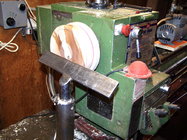
I do twice turning at least 95% of the time and use a recess in pretty much every turning I make, some do still have a tenon from the turnings I did 20 years or longer ago.
Yes the wood does warp, most are oval, and I can and do chuck the oval recess, the jaws can grab the oval on 4 spots and hold good enough for me to turn the piece, or I hold it in the Jumbo jaws and return the recess.
I'm sure I do not win the time race turning, but I have fun doing it my way and do get pretty nice pieces that I like.
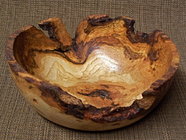
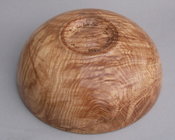
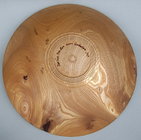

I do twice turning at least 95% of the time and use a recess in pretty much every turning I make, some do still have a tenon from the turnings I did 20 years or longer ago.
Yes the wood does warp, most are oval, and I can and do chuck the oval recess, the jaws can grab the oval on 4 spots and hold good enough for me to turn the piece, or I hold it in the Jumbo jaws and return the recess.
I'm sure I do not win the time race turning, but I have fun doing it my way and do get pretty nice pieces that I like.



I use a vac chuck for just about every bowl - my system is very simple to setup - takes less than 30 seconds to switch over. But I do leave the bowl in the chuck, apply very dilute sanding sealer to the inside and let it dry thoroughly before setting up in the vac chuck. So I’ll have several bowls sitting around in chucks drying until I’m ready to do a session of finishing, sometimes they’ll wait a day…
Tom Gall
TOTW Team
@Larry Copas I agree! Almost every piece I turn (except for some spindle stuff) sees a vacuum chuck at one point or another. My first semi-production item was a small hand/pocket mirror in 1994 - totally turned with a vacuum chuck ... followed by other small items. Where a vacuum chuck really excels is when making a necessary repair of any kind - the easiest, and often the only way, to remount a piece.
I liked my VC until I ended up "tattooing" a few pieces with dust and/or finish, and I couldn't erase or blend the transition point. May I ask, you folks that are using VCs successfully, what are you doing to prevent pulling in dust/finish and essentially staining the zone under the vacuum?
I don’t apply the finish until after I am done turning the piece.I liked my VC until I ended up "tattooing" a few pieces with dust and/or finish, and I couldn't erase or blend the transition point. May I ask, you folks that are using VCs successfully, what are you doing to prevent pulling in dust/finish and essentially staining the zone under the vacuum?
Ditto.I liked my VC until I ended up "tattooing" a few pieces with dust and/or finish, and I couldn't erase or blend the transition point. May I ask, you folks that are using VCs successfully, what are you doing to prevent pulling in dust/finish and essentially staining the zone under the vacuum?
Tom Gall
TOTW Team
Let it cure/dry fully. Pulling dust? ... never had that problem after a finish was applied.I liked my VC until I ended up "tattooing" a few pieces with dust and/or finish, and I couldn't erase or blend the transition point. May I ask, you folks that are using VCs successfully, what are you doing to prevent pulling in dust/finish and essentially staining the zone under the vacuum?
Thanks, Rusty, Dean, and Tom. So Rusty and Dean, you don't get any dust pulled into the pores in the wood? Tom, I wonder if insufficiently dried finish was the issue. I can run a test on a scrap bowl and see. Also, would the intensity of the suction possibly be a contributor to the discoloration? In other words, do you think too high a suction could slightly damage/alter the cells such that the suction "zone" appears slightly darker?
Tom Gall
TOTW Team
Yes, Steven, most likely your finish wasn't dried/cured enough. The vacuum is probably pulling some still uncured finish through the pores. Take a scrap bowl, as you mentioned, put some finish on the exterior and then put it on your vacuum chuck while wet ... you will get an idea of how vacuum will pull finish through the pores - some woods (i.e. oak) more than others.Thanks, Rusty, Dean, and Tom. So Rusty and Dean, you don't get any dust pulled into the pores in the wood? Tom, I wonder if insufficiently dried finish was the issue. I can run a test on a scrap bowl and see. Also, would the intensity of the suction possibly be a contributor to the discoloration? In other words, do you think too high a suction could slightly damage/alter the cells such that the suction "zone" appears slightly darker?
No, I don't think high suction would damage the wood's cell structure.
You might want to use a disc-type vac chuck - then if you do have any minor discoloration it would be on the entire interior surface. Of course, that won't work with a natural edge bowl. Do a search on the forum - this has been discussed quite recently.
I have never noticed a dust problem. I have also put bowls back on the VC after the finish has dried and cured and not seen a problem. I can see where it might be a problem for those that like to finish on the lathe. I have never seen a need or advantage to doing that.Thanks, Rusty, Dean, and Tom. So Rusty and Dean, you don't get any dust pulled into the pores in the wood? Tom, I wonder if insufficiently dried finish was the issue. I can run a test on a scrap bowl and see. Also, would the intensity of the suction possibly be a contributor to the discoloration? In other words, do you think too high a suction could slightly damage/alter the cells such that the suction "zone" appears slightly darker?
Like Rusty, I haven't really had a problem. Blow them off with air after removing from the vacuum chuck and do what you want with them. As noted, I don't apply finish on the lathe anymore, except the inside of boxes where I use friction polish. Boxes are on a tenon and not the vacuum at that point. For other pieces and finishes, there's just too much airborne crap, and it ties up the lathe.
Rather than a tube or bowl-shaped chuck, mine is a flat plate (what Tom Gall called a disc-style) with 1/16th" foam on the surface. Those dust hickies inside the bowl, whether they've got finish involved or not, are impossible to remove, which is why I've stopped using the tube-style chucks on the interior of bowls. With the flat chuck (looks like a great big faceplate), you simply put the rim of the bowl on the plate, bring up the tailstock to center it and turn on the vacuum. The contact point between the bowl and the vacuum gasket is the rim, rather than the interior wall. Any dust line is much, much harder to see>I liked my VC until I ended up "tattooing" a few pieces with dust and/or finish, and I couldn't erase or blend the transition point. May I ask, you folks that are using VCs successfully, what are you doing to prevent pulling in dust/finish and essentially staining the zone under the vacuum?
In the photos, you can see the bowl adhered to the vacuum plate, ready for the foot to get turned, and in the side view you can see that the gasket foam is just loosely attached to the plate with a bit of double-stick tape. There's no reason to glue your gasket foam down, unless scraping old busted gasket foam and glue off of your chuck is fun for you. The vacuum will hold it in place enough to make the seal, and the tape holds it in place enough to keep it there when the vacuum isn't on.
